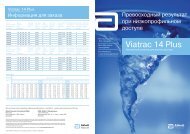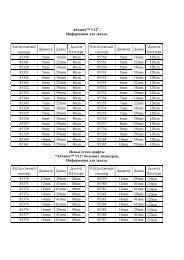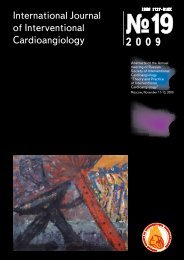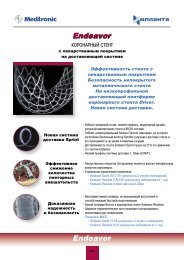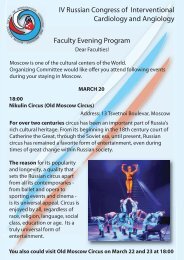Results of Coronary Stenting using the Stents with
Results of Coronary Stenting using the Stents with
Results of Coronary Stenting using the Stents with
Create successful ePaper yourself
Turn your PDF publications into a flip-book with our unique Google optimized e-Paper software.
Interventional cardiology<br />
it, and under <strong>the</strong>ir influence <strong>the</strong> process <strong>of</strong> endo<strong>the</strong>lization<br />
does not end by 6 months, but continues<br />
fur<strong>the</strong>r. Never<strong>the</strong>less this process leads to stepwise<br />
decrease <strong>of</strong> minimal lumen <strong>of</strong> <strong>the</strong> dilated segment<br />
<strong>of</strong> <strong>the</strong> artery. The growth <strong>of</strong> neointima does not stop<br />
even after 12 months (74). Karvouni et al. (73) have<br />
noted that by 15 months after Cypher (Sirolimuseluting)<br />
implantation, <strong>the</strong> stent was not covered by<br />
<strong>the</strong> endo<strong>the</strong>lium; at <strong>the</strong> same time BX Velocity (bare<br />
metal) stent was completely endo<strong>the</strong>lized. In 2005,<br />
Waters (75) has presented 40 pathological cases<br />
after DES implantation: in 24 <strong>of</strong> <strong>the</strong>se cases <strong>the</strong>re<br />
was a thrombosis <strong>of</strong> <strong>the</strong> stented segment. It became<br />
evident, that <strong>the</strong> delay <strong>of</strong> endo<strong>the</strong>lization after DES<br />
implantation prolong <strong>the</strong> time when <strong>the</strong> development<br />
<strong>of</strong> complications is possible. These complications<br />
include thrombosis — <strong>the</strong> most dangerous adverse<br />
event after DES implantation (76).<br />
Long-term follow-up <strong>of</strong> 746 patients in whom<br />
Clopidogrel was stopped 6 months after stenting<br />
(Basket-Late trial) have been presented in March<br />
2006, at <strong>the</strong> Annual session <strong>of</strong> ACC (77). The study<br />
revealed that <strong>with</strong>in 1 year after <strong>the</strong> cessation <strong>of</strong><br />
Clopidogrel intake <strong>the</strong> rate <strong>of</strong> complications in patients<br />
<strong>with</strong> DES was reliably higher than in those <strong>with</strong><br />
BMS. Here<strong>with</strong> in <strong>the</strong> group <strong>with</strong> DES <strong>the</strong>re was a<br />
tendency towards lower need in repeated PCI for restenosis<br />
(78). Wenaweser at al. (77) have shown that<br />
an angiographically confirmed stent thrombosis was<br />
noted in 1,8% <strong>of</strong> cases. Almost one half <strong>of</strong> thromboses<br />
(41%) were late (on <strong>the</strong> average — in 453 days).<br />
The majority <strong>of</strong> late thromboses (59%) occurred<br />
more than one year after stenting (77).<br />
One can suggest, that <strong>the</strong> obtained results, if <strong>the</strong>y<br />
are not accidental and are not related to some particularities<br />
<strong>of</strong> <strong>the</strong> trial, favor more prolonged (over 6<br />
months) administration <strong>of</strong> Clopidogrel after <strong>the</strong> implantation<br />
<strong>of</strong> DES. Eisenstein et al. (79) presented<br />
<strong>the</strong> results <strong>of</strong> <strong>the</strong>ir study <strong>of</strong> 4666 patients followed for<br />
6, 12, and 24 months after stenting. In patients <strong>with</strong><br />
bare metal stents prolonged Clopidogrel <strong>the</strong>rapy had<br />
no impact on <strong>the</strong> rate <strong>of</strong> death and MI at 6-12 months<br />
after <strong>the</strong> procedure. On <strong>the</strong> contrary, in patients <strong>with</strong><br />
DES <strong>the</strong> use <strong>of</strong> Clopidogrelfor 6, 12 and 24 months<br />
was associated <strong>with</strong> <strong>the</strong> decreased rate <strong>of</strong> mortality<br />
and MI in all time intervals.<br />
At present we assist at <strong>the</strong> introduction <strong>of</strong> new<br />
techniques <strong>of</strong> stenting, including simultaneous use<br />
<strong>of</strong> DES and BMS, <strong>the</strong> so-called “hybrid” stenting. A<br />
group <strong>of</strong> Italian researchers headed by Varani has<br />
followed 2898 patients <strong>with</strong> coronary artery disease<br />
who underwent multiple coronary stenting, from July<br />
2003 through December 2006 (81). BMS have been<br />
implanted in 1315 <strong>of</strong> <strong>the</strong>se patients, DES — in 657,<br />
and 926 patients had “hybrid” stenting. Long-term<br />
results (2 years) suggest <strong>the</strong> absence <strong>of</strong> any significant<br />
difference between <strong>the</strong> outcomes <strong>with</strong> <strong>the</strong> use<br />
<strong>of</strong> DES and “hybrid” stenting. It has been shown that<br />
isolated use <strong>of</strong> DES is more cost-effective in comparison<br />
<strong>with</strong> <strong>the</strong> use <strong>of</strong> only BMS.<br />
Bertand et al. (82) have compared two groups <strong>of</strong><br />
patients: <strong>the</strong> patients from group 1 (n=161) received<br />
only DES, while <strong>the</strong> patients from group 2 (n=201) —<br />
a combination <strong>of</strong> DES and BMS. Long-term results <strong>of</strong><br />
“hybrid” stenting were found to be comparable <strong>with</strong><br />
<strong>the</strong> results <strong>of</strong> DES implantation. The authors have<br />
confirmed <strong>the</strong> effectiveness <strong>of</strong> isolated use <strong>of</strong> DES in<br />
coronary lesions <strong>with</strong> high risk <strong>of</strong> restenosis.<br />
Conclusion: Sirolimus-eluting stents marked<br />
<strong>the</strong> advent <strong>of</strong> a new generation <strong>of</strong> intravascular<br />
devices. They have been followed by o<strong>the</strong>r stents<br />
<strong>with</strong> similar and essentially different types <strong>of</strong> coating.<br />
Their apparition can be considered as a logical<br />
evolutionary step in invasive cardiology, while <strong>the</strong><br />
decrease <strong>of</strong> <strong>the</strong> risk <strong>of</strong> restenosis can mean <strong>the</strong> beginning<br />
<strong>of</strong> a new era in revascularization. Certainly,<br />
significant decrease <strong>of</strong> <strong>the</strong> rate <strong>of</strong> restenosis and<br />
TLR <strong>with</strong> <strong>the</strong> use <strong>of</strong> DES (in comparison <strong>with</strong> BMS)<br />
has been proved by multiple trials, and constitutes<br />
<strong>the</strong> main advantages <strong>of</strong> <strong>the</strong>se stents. A representative<br />
<strong>of</strong> second generation <strong>of</strong> DES, Everolimus-eluting<br />
stent Хience V, is superior to Sirolimus-eluting,<br />
as well as to Paclitaxel-eluting stents. Today we assist<br />
at <strong>the</strong> development and successfully introduction<br />
<strong>of</strong> a third-generation DES — <strong>with</strong> PLA-based<br />
biodegradable coating, that has been shown to be<br />
safe and effective in early, as well as in long-term<br />
follow-up (68). However, <strong>the</strong> true innovation in this<br />
field was <strong>the</strong> advent <strong>of</strong> new stents, implanted into<br />
<strong>the</strong> thrombotic vessels. After <strong>the</strong> implantation <strong>the</strong>y<br />
dissolve <strong>with</strong>in about 2 years leaving <strong>the</strong> vessel<br />
patent in <strong>the</strong> absence <strong>of</strong> a permanent metallic implant<br />
(80).<br />
References<br />
1. Petrosian Yu.S., Zingerman L.S. Coronarography.<br />
Moscow, Meditzina, 1974. 150 p.<br />
2. Rudd J.H.F. , Davies J. R., Weissberg P.L. A<strong>the</strong>rosclerotic<br />
Biology and Epidemiology <strong>of</strong> Disease. In<br />
Topol E.J. Textbook <strong>of</strong> cardiovascular medicine. Lippincott<br />
Williams & Wilkins, Philadelphia, 2002.<br />
3. Gruentzig A. Transluminal dilatation <strong>of</strong> coronary-artery<br />
stenosis. Lancet, 1978, 1, 263.<br />
4. Sigwart U., Puel J., Mirkovitch V., et al. Intravascular<br />
stents to prevent occlusion and restenosis after<br />
transluminal angioplasty. N. Engl. J. Med., 1987,<br />
326, 701-6.<br />
5. Gianturco C, Wright KC, Wallace S, et al. Percutaneous<br />
endo-vascular stents: An experimental<br />
evaluation. Radiology, 1985, 156 (1), 69-72 .<br />
6. Garas SM, Huber P, Scott NA. Overview <strong>of</strong><br />
<strong>the</strong>rapies for prevention <strong>of</strong> restenosis after coronary<br />
interventions. Pharmacol. Ther., 2001, 92(2-3), 165-<br />
78.<br />
7. Serruys P.W., de Jaegere P., Kiemeneij F., et al.<br />
A comparison <strong>of</strong> balloon-expandable stent implantation<br />
<strong>with</strong> balloon angioplasty in patients <strong>with</strong> coronary<br />
artery disease: BENESTENT study group. N. Engl. J.<br />
Med., 1994, 331, 489–509.<br />
30<br />
(№ 26, 2011)




